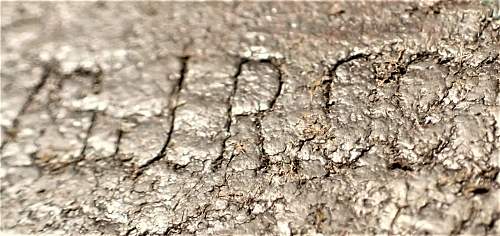-
 K98 Bayonet frog marked for Gebrigsjäger Regiment 98
K98 Bayonet frog marked for Gebrigsjäger Regiment 98
K98 Bayonet Frog marked 10.G.J.R. 98 I
10th Company, Gebrigsjäger Regiment 98
(Gebirgs-Jäger-Regiment 98)
The 1st Mountain Division, of which Gebirgsjäger-Regiment 98 was a part of, had an extensive combat history but also includes some extremely brutal war crimes in Greece against Italian soldiers and Greek civilians. For more information search “War crimes of the 1st Mountain Division in the Balkans”.
The Gebirgsjäger-Regiment 98 was formed on 12 October 1937 in Wehrkreis VII.
The regiment was subordinated to the Mountain Brigade after its formation.
From 9 April 1938, the regiment was subordinate to the 1st Mountain Division.
1939 - Poland
On 5 September 1939, the regiment crossed the german-Polish border from Presow in Slovakia eastwards of the High Tatras without enemy action.
On September 11, the Sambor road junction was captured. West of the Strait of Grodek, three Polish divisions were encircled, which were destroyed by 18 September 1939.
On September 20, 1939, the regiment met Russian troops near Lviv, who occupied Eastern Poland in the course of the Hitler-Stalin Pact.
1940 - France
From 10 May 1940, the regiment marched through Luxembourg and Belgium to France.
By 13 May 1940, the regiment had reached the area of St. Hubertus without any enemy contact.
On 14 May 1940 the regiment reached the Meuse, which was crossed on 15 May at Fumay and Revin and then advanced on Rocroi. Through Rocroi, the regiment advanced on Hirson.
On 19 May 1940, the direction of the march was changed to the southwest towards the Oisne-Aisne Canal.
On 6 June 1940 the attack continued in the direction of Aisne.
On the evening of June 9, 1940, the small course of the River Ourcq was reached. The next day, large parts of the enemy in front of the regiment surrendered, so that the rapid pursuit was carried out.
On June 15, 1940, Louan and Provins were taken and St. Colombe was reached. At Gien, the Loire was crossed.
On June 19, 1940, the Cher Bridge was taken at Quincy.
In August 1940, the regiment was transferred to the Arras area. Loading exercises were carried out there in preparation for landing in England.
At the end of October 1940, the regiment moved to the Besancon area to the Le Valdahon military training area. Here the troops were gathered for The Operation "Felix", the conquest of Gibraltar which was later called off.
1941 – Yugoslavia, Ukraine
By 8 April 1941, all parts of the regiment had been reached in the meeting room on both sides of the Drava between Völkermarkt, Bleiburg and St. Paul. On April 6, 1941, the attack on Yugoslavia began.
On April 13, 1941, the advance of the regiment ended. It was taken back on Cilli after the Yugoslav forces surrendered.
On June 22, 1941, the regiment advanced on Russian soil. And already on the first day there were fierce fights in the border area.
On June 23, 1941, the attack continued. The regiment reached the road Yatsov Stary - Niemirov.
On June 25, 1941, there were Russian tank attacks against the regiment.
By June 29, 1941, the area around Lviv was reached, where the regiment 1 1/2 years earlier had already stood. Lviv was evacuated by the Russians without a fight and the regiment marched into the city on June 30, 1941.
On July 4, 1941, the regiment marched southwest via Winniki towards Husiatyn.
By mid-July, the Stalin Line was reached. It was possible to lead parts of the regiment behind the Russian defensive positions at Galusinzy in a covered stream bottom and to roll up the Russian positions from backwards. After this breakthrough, the regiment Wieter advanced on Vinnitsa.
On the evening of July 18, 1941, the two bridges at Vinnitsa were reached and the Russian troops standing west of the Bug were cut off from their way back.
After the Battle of Vinnitsa, there were chases towards Uman.
On August 2, 1941, the regiment was able to gain the connection to the 9th Panzer Division and the 4th Mountain Division at Ternowka. Heavy fighting broke out around the enclosed Podvyskoye, during which several attempts by Russian troops to break out. The battle lasted until August 7, 1941.
On the night of September 3, 1941, pioneers succeeded in building a bridge over the Dnieper river near Berislaw.
On the night of September 9, 1941, the regiment passed the bridge and was deployed in the resulting bridgehead.
On September 13, the regiment stood in the area of Antonovka in the Noga Steppe.
On September 19, 1941, the tank trench of Timoshevka was reached.
On September 20, 1941, the order was issued to attack the tank trench, which was heavily defended. The regiment managed to break into the Russian positions and break through them, so that the march to the southeast could be resumed. But after only a few hours the counter-order came: the regiment had to turn to the east to smash the enemy that had broken through at Balki.
Until October 4, 1941, this task was carried out. The advance continued towards the Ukrainian industrial area of Stalino-Makeevka, where fierce fighting broke out. It was not until October 21, 1941 that the heavy fighting for the city ended.
1942 –Ukraine, Russia
On May 17, 1942, the attack on Barvenkovo began, in which the regiment was able to break through the Russian positions and take Barvenkovo. Three Russian armies were trapped in the Bereka Valley and destroyed by 29 May 1942.
On August 5, 1942, the Don was crossed, in the period from August 12 to 21, 1942, the high passes of the Caucasus between the Elbrus, Maruch, Bgala and Assapse Pass were taken.
By September 1942, Russian pressure on the German positions had increased more and more. At the beginning o September 1942, the regiment was withdrawn from the high mountain front and transferred via Maikop to the Pontic Caucasusu. From here it was to be pushed through Tuapse and the Black Sea.
On September 24, 1942, the attack began, three days later, after numerous bunker fights, the Gunai Mountain was taken.
On October 28, 1942, the Ssemanschcho mountain could be conquered, the view of the Black Sea was free. But here it did not go any further. Russian troops attacked the mountain troops and inflicted heavy losses on them. The summit of Ssemanschcho changed hands several times. Until 13 December 1942, the mountain troops were able to hold on to disproportionate losses before they had been allowed to retreat by the OKW.
1943 – Russia, Montenegro, Greece, Bosnia, Croatia
On the night of January 23, 1943, the last mountain positions on the Lyssaya were cleared. The regiment retreated into the looming Kuban bridgehead.
In January, the Kuban was crossed at Usty-Labinskaya. On January 31, 1943, the Gothic position was taken. Subsequently, the Hubertus position was taken until 5 February and from 22 February 1943 the Poseidon position.
On March 22, 1943, the regiment was withdrawn from the front and transferred to the Crimea. By train we went from here to the Balkans. From Bulgaria, the regiment moved to the black mountains of Montenegro, where it arrived in April 1943.
In the Balkans, there was heavy and fierce fighting with Tito partisans during "Operation Black" in May 1943, and on June 16, 1943, the regiment was transferred to Greece.
The regiment marched to Skoplje and received tropical clothing there. Subsequently, the regiment moved to the room of Epirus. Here, too, there were partisan missions.
On August 14, 1943, the regiment was ordered to prepare for an attack on the Greek village of Komeno. After the surrender of Italy, parts of the regiment transferred to the island of Kefalonia, held by Italian troops.
In December 1943, the regiment was again deployed against partisans in Bosnia and Croatia.
1944/45 – Hungary, Greece, Montenegro, Serbia, Austria/Slovenia border
In March 1944, the regiment moved to Hungary to secure the apostasy of the former ally. By March 31, Hungary had been fully occupied. The regiment then returned to Greece.
Until July 20, there were again partisan missions. In the course of the general withdrawal, Greece was evacuated. Subsequently, the regiment was again deployed in Montenegro against Tito partisans.
In September 1944, the regiment was deployed between Vlasotine and Zajecar.
By mid-October 1944, the regiment moved via Pozarevac to the area south of Belgrade.
The regiment was encircled in Belgrade. On October 18, the eruption of the encircled troops began and the Russian lines were broken with enormous losses. After the outbreak, the remnants of the regiment were provisionally replenished and used from November 1944 to March 1945 between Drava and Lake Balaton.
After the heavy fighting at Lake Balaton, the 1st People's Mountain Division had to retreat to Styria. On May 9, 1945, the regiment went into American captivity, the soldiers were sent to the prisoner-of-war camp in Mauerkirchen.
Note: I added the S84/98 bayonet. I purchased the frog by itself and all my K98 bayonets have a frog so I put the S84/98 with it until I find a 1930's K98 matching number bayonet. The frog looked empty without a bayonet.





Last edited by Douglas; 09-02-2022 at 04:48 PM.
-
09-02-2022 03:25 PM
# ADS
Circuit advertisement

-

The frog is equally interesting in that it has had a replacement retaining strap fitted. The early versions put the strap through the cut out holes, later versions fitted the strap between the two pieces of leather making the hanger. Also the strap itself appears to be re-used leather as it is stitched at the end, recycling leather was common mid to late war, which is an indication of when the repair occurred.
-

These two variants were produced until the end of the war. One can hardly speak of an early and late variant.
Here a damaged safety strap was replaced and sewn on.
Regards
-

"These two variants were produced until the end of the war. One can hardly speak of an early and late variant."
Unit marked equipment tends to be Reichswehr until around 1938-39. I suspect and order was made not to put unit markings on equipment.
-

Hello,
The Reichswehr was officially renamed the Wehrmacht in 1935. Although the name Wehrmacht was also used before.
The affixing of troop stamps in the army was discontinued in the course of 1940. Stamping of the bayonets was discontinued in 1934.
Stamped frogs were also used until 1945.
Regards
-


by
Sleepwalker

Hello,
The Reichswehr was officially renamed the Wehrmacht in 1935. Although the name Wehrmacht was also used before.
The affixing of troop stamps in the army was discontinued in the course of 1940. Stamping of the bayonets was discontinued in 1934.
Stamped frogs were also used until 1945.
Regards
You are correct of course. I should have included the unmasking and change to TR. Good to know the unit stamps were ended in 1940. I collect buckles with unit marked tabs and that explains why I haven't found a steel buckle with a unit marked tab yet.
Thank you,
Doug
Last edited by Larry C; 09-06-2022 at 03:21 PM.









 .
.




Bookmarks